Head and Shoulders and Inverted Head and Shoulders Pattern- Steemit Crypto Academy- S5W2- Homework post for @utsavsaxena

Hello everyone...
I am very delighted to have taken part in this week's lecture with professor @utsavsaxena. Having learnt about the various reversal patterns, I can tell that my knowledge of market analysis and cryptocurrency trading has improved significantly.
With the understanding I gained from class, I have deployed my knowledge to solve the homework task presented below.
Q1: Explain Head and Shoulder and Inverse Head and Shoulders patterns in detail with the help of real examples. What is the importance of volume in these patterns(Screenshot needed and try to explain in detail)
Over the years, chart patterns have been deployed by traders to make predictions on the market. Several chart patterns exist and are used in diverse market situations - uptrend, range-bound, or downtrend.
Chart patterns are particularly useful in identifying points of trend reversal or continuation. In other words, if chart patterns are properly utilized, they can help traders identify when a market trend is set to continue in, or reverse from, a certain direction.
The Head and Shoulder/Inverse Head and Shoulder patterns are both in the category of reversal patterns. That is, they often occur at points where the existing market trend is exhausted and due for a reversal. Let's consider each of these chart patterns in more detail below.
Head and Shoulder pattern
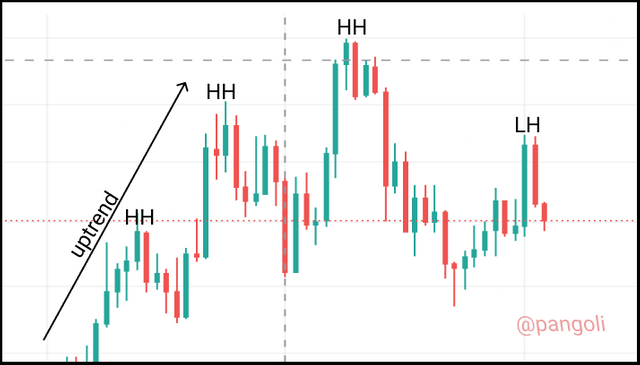
Image source
The head and shoulder pattern usually comes up to mark the end of a bullish trend. Whenever this pattern appears on a price chart, it is believed that a market that was previously in an uptrend is set to reverse in the opposite direction.
The structure of this pattern exists such that there are three inconsistent price peaks clustered around each other. The first peak is commonly called the left shoulder, and is usually lower than the second. The second peak, which is called the head, follows after the first and is always the largest in size. The third peak, which is the right shoulder, comes after the second and is usually about the size of the first.

Image source
Also, there is an item in this chart pattern called the neck line. The neckline joins the low points of the left shoulder, and the head. Thereby, providing a guiding trend line that has to be broken by the second leg of the right shoulder to confirm that the trend is changing direction.
Inverse Head and Shoulder pattern
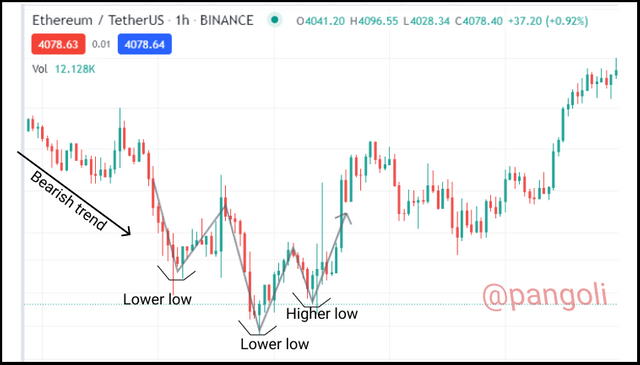
Image source
The inverse head and shoulder pattern is often regarded as the mirror image of the head and shoulder pattern. While the former applies in an upward trending market, the latter applies in a downward trending market.
The inverse head and shoulder pattern, in most cases, signify the end of a downtrend. Whenever this pattern appears on a price chart, it is believed that a market that was previously in a downtrend is set to reverse into an uptrend.
This pattern is also structured such that there are three inconsistent price bottoms clustered around each other. The first bottom is commonly called the left shoulderand is usually higher than the second. The second bottom which is lower than the first is called the head, and is always the largest in size. The third bottom, which is the right shoulder, comes after the second and is usually about the size of the first.

Image source
This chart pattern also have a neck line that joins the high points of the left shoulder, and the head. Thereby, providing a guiding trend line that has to be broken by the second leg of the right shoulder to confirm that the trend is changing direction.
Importance of volume in head and shoulder and inverse head and shoulder patterns
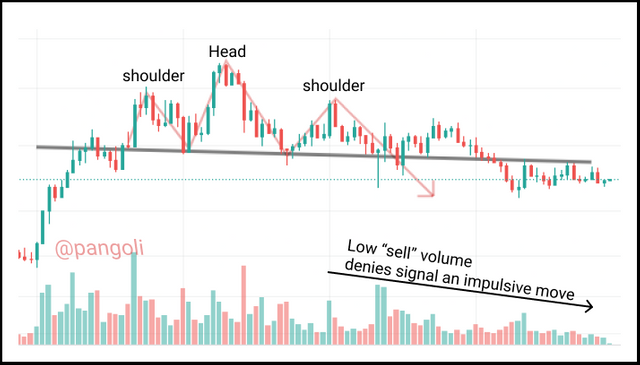
Image source
It is possible to have a chart pattern printed and the market does the exact opposite of what was expected. At this point, several factors can be responsible for the price action. That is why it is always advised that every signal be confirmed with other relevant indicators.
Indicators like volume bars can help validate the authenticity of a chart pattern. If a chart pattern is printed, and there is not enough volume to push the trend in the suggested direction, the candlestick pattern will be violated.
Conversely, if a chart pattern is printed, and there is sufficient volume in favour of the suggested direction, it can be confirmed that the signal from the chart pattern is authentic and is most likely to play out
Q2: What is the psychology behind the reversal patterns discussed in Q1?
Head and Shoulder
As earlier explained in Q1 above, the head and shoulder pattern often signifies a bullish-bearish trend reversal. let's gain more clarity on this with the illustration below:
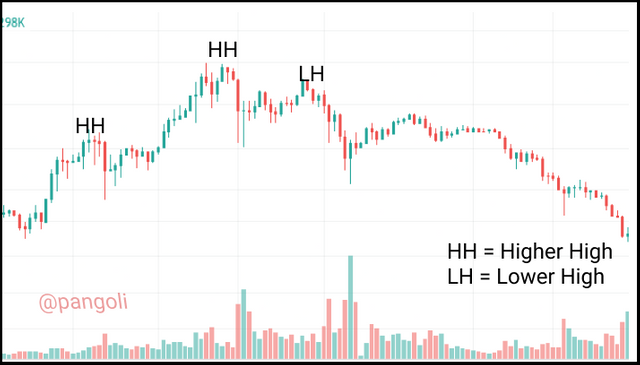
Image source
From the screenshot above, after a series of higher highs, there is a price decline, subsequently leading up to another high. This time, the price peak is lower than the preceding one - that is, a lower high.
Traders at this point have noticed the interruption in what was originally an uptrend, and are beginning to expect a confirmation that the trend has changed so they liquidate their long positions.
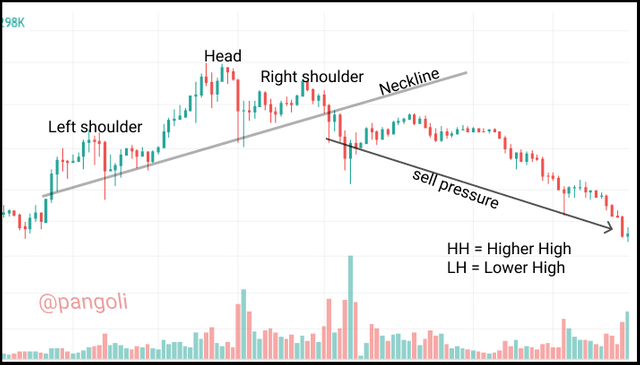
Image source
As expected, the descends from the third peak and breaks through the supporting trend line to close below the previous low. At this point, traders are no longer hoping for a resumption of an uptrend, so they liquidate their long positions and start entering short trades to ride the downtrend.
As more traders liquidate their long positions to start betting on a downward trending market, the sell pressure is intensified and further pushes down the price.
Psychology of Market behind the Inverse Head and Shoulder pattern
This reversal pattern is a bearish-bullish setup that signals the end of a downtrend. Let's explore a more detailed explanation using the screenshot below.
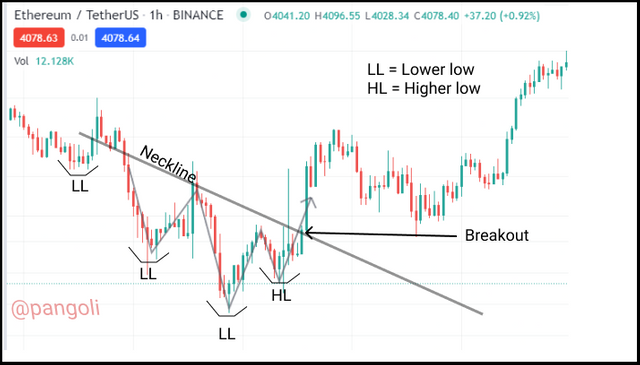
Image source
From the screenshot, after a series of lower lows, the price begins to trend downwards, subsequently leading up to another low. This time, the candlestick pattern's bottom is higher than the preceding one - that is, a higher low.
Traders at this point have noticed the interruption in what was originally a downtrend, and are beginning to expect a confirmation that the trend has changed so they exit their short positions.
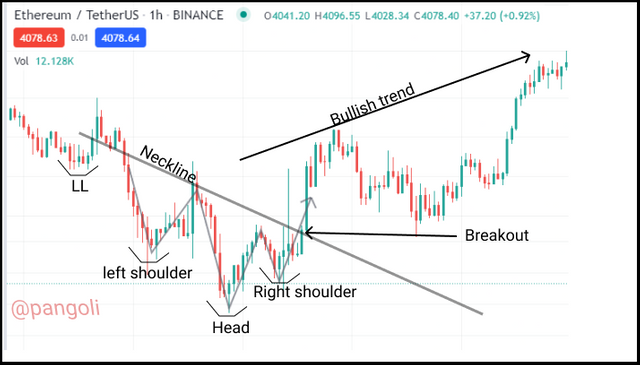
Image source
As expected, the price begins to trend upwards from the third peak and breaks through the trend line to close above the previous high point. At this point, traders are sure that there is no possibility of having the previous trend resume, so they exit their short positions and start entering long trades to ride the coming uptrend.
As more traders exit their short positions to start betting on an upward trending market, the "buy" pressure is intensified and further pushes the price up.
Q3: Explain 1 demo trade for Head and Shoulder and 1 demo trade for Inverse Head and shoulder pattern.
Case 1: Head and Shoulder pattern
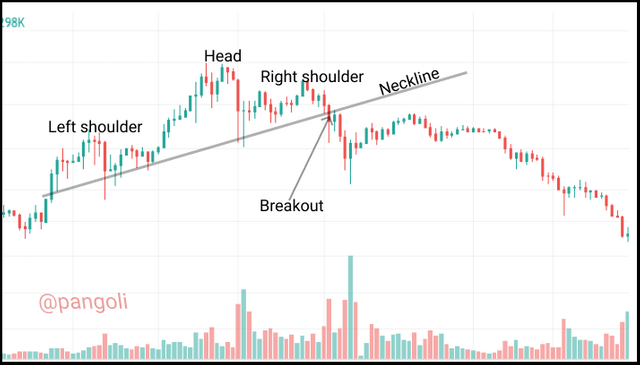
Image source
Price action has already established the left shoulder and the head, and the right shoulder. I have drawn a neckline across the bottom of the first shoulder and the head, respectively. The neckline becomes my dynamic support line to watch out for a breakout upon the completion of the second shoulder.
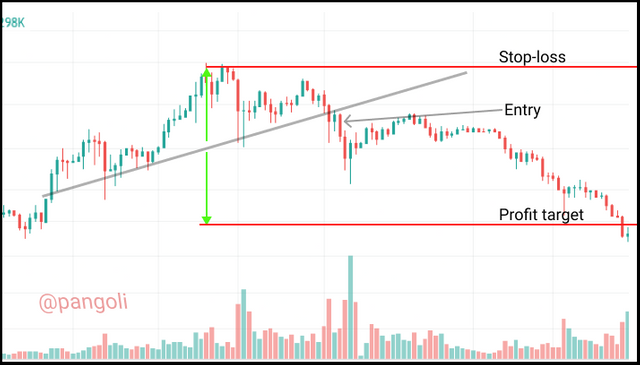
Image source
Once the right shoulder breaks through the neck line -the dynamic support, and closes below the neckline; I proceeded to place my entry point just below the neckline. Also, I defined my target point to take profit, as well as my stop-loss order.
Case 2: Inverse Head and Shoulder pattern
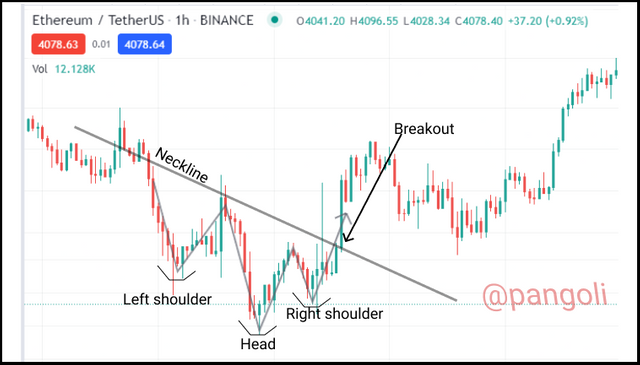
Image source
From the chart, the head and shoulder pattern is already visible. The price action has already established the left shoulder, the head, and the right shoulder. Also, the neckline, which is a dynamic resistance line is drawn across the top of the first shoulder and the head, respectively. This neckline becomes a crucial determinant of the next market move, depending on whether it gets broken by the right shoulder or not.
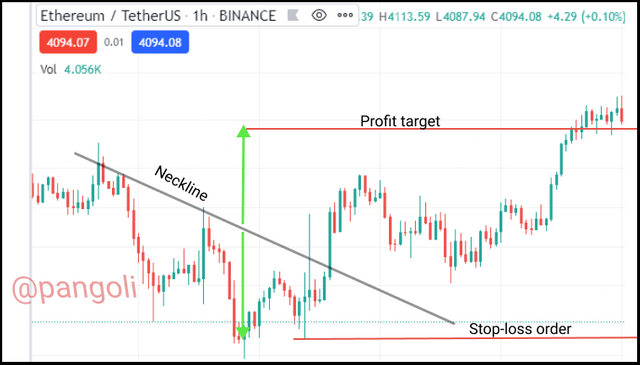
Image source
Once the right shoulder breaks through the neck line -the dynamic resistance, and closes above the neckline; I proceeded to place my entry point just above the neck line. Also, I defined my target point to take profit, as well as my stop-loss order.
- Place 1 real trade for Head and Shoulder(at least $10) OR 1 trade for Inverse Head and Shoulder pattern(at least $10) in your verified exchange account.
For this exercise, I will do my analysis on the SAND/USDT pair using the tradingview platform.
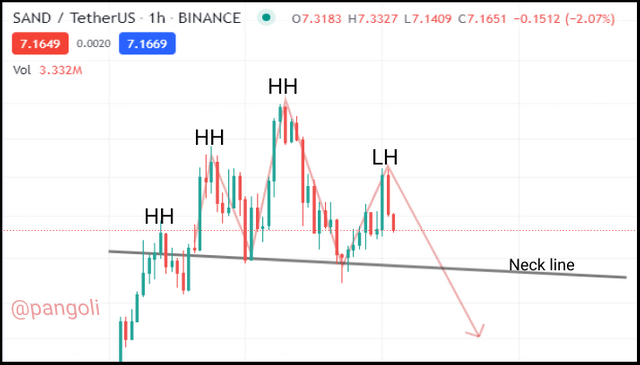
Image source
First, I identified the formation of a potential head and shoulders pattern when I saw the interruption of an uptrend. The consistent higher highs lost its uniformity when a lower high was printed just after the previous high. I decided to mark these points and watch the trade play out.
I marked the respective head and shoulders, and drew the neckline to further validate when the trend is reversing.
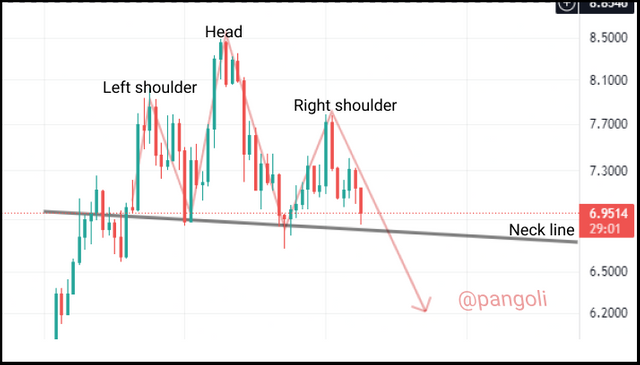
Image source
As I had expected, the pattern got fully formed and the second leg of the right shoulder broke through the neckline, this was an obvious confirmation that the initial trend has reversed in the opposite direction. Having established this fact, I proceeded to define my entry and exit point.
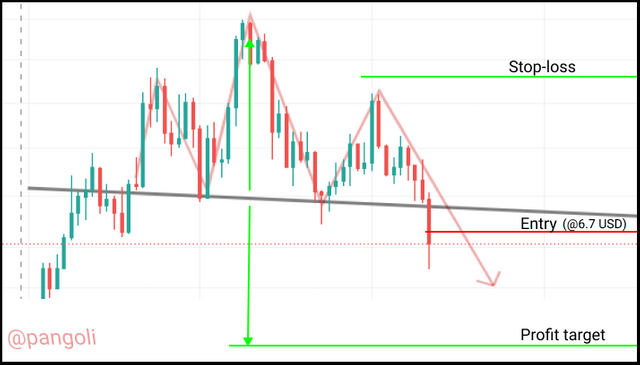
Image source
I set my entry point at 6.7 and placed my profit target at a length equivalent to the distance between the peak of the head and the neckline. Also, I placed my stop-loss just above the peak of the right shoulder.
Having done these, I proceeded to the exchange platform to place my trades. Meanwhile, here is a screenshot of my verified Binance account below.

Let's proceed to place our trade as analyzed above using this exchange platform...
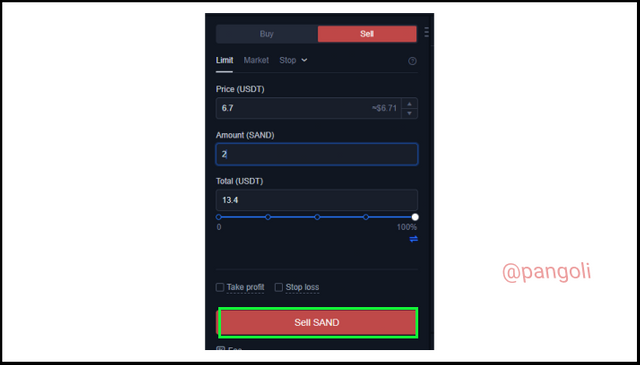
Image source
I have set the trade to "sell" and filled my order price and quantity as shown on the screenshot above. Then I proceeded to "Sell SAND"
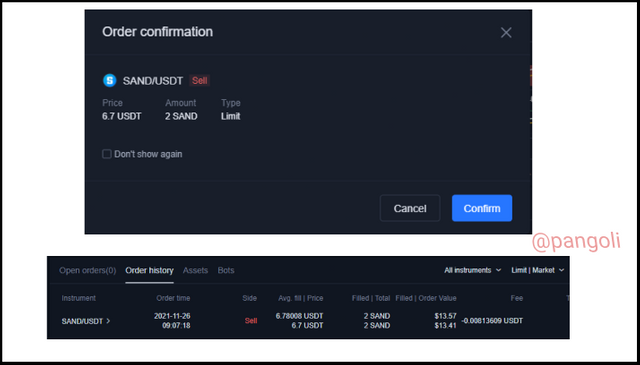
Image source
I confirmed my trade on the dialog box that appeared and it was filled. The screenshot of my open order is presented along the order confirmation dialog box above.
Conclusion
Chart patterns provide an easy visual way to identify major change in the market. Reversal patterns like the head and shoulders, or the inverse head and shoulders, can help traders spot when the market trend is about to reverse in the opposite direction - either up or down.
A proper knowledge and application of the information gathered from these market chart patterns can provide traders with the necessary information to avoid taking trades that end up liquidating in loses.
Thank you for reading...
CC:-
@utsavsaxena